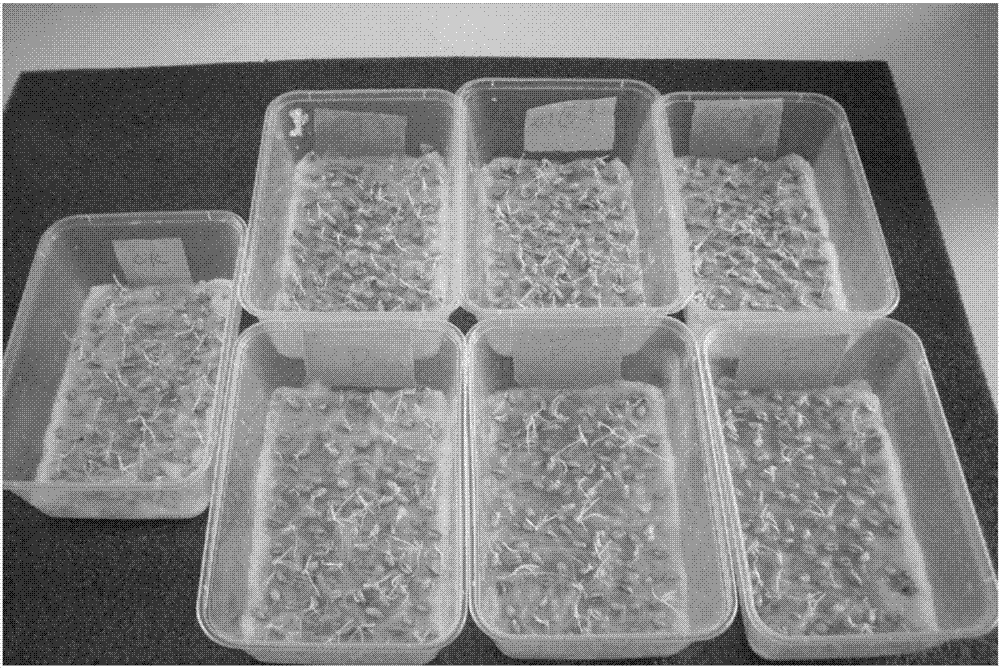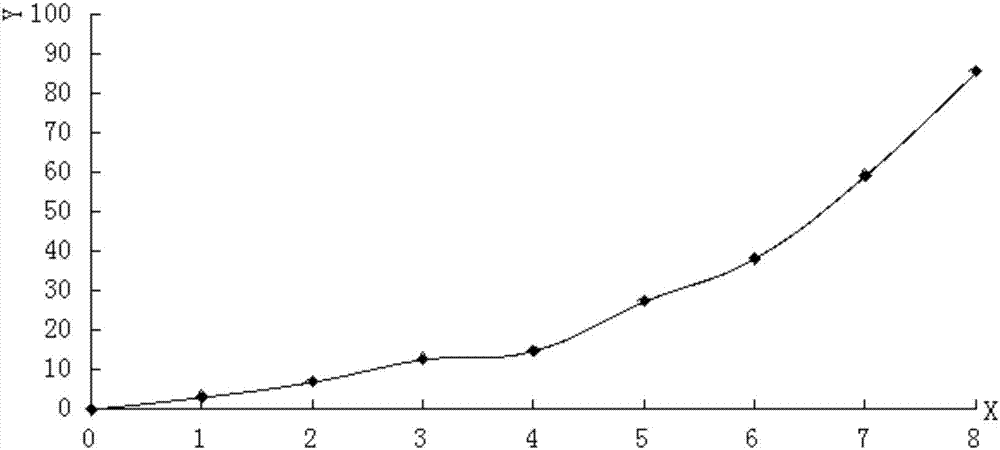A method for testing the disease resistance of wheat varieties and its application
A disease resistance, wheat technology, applied in application, seed and rhizome treatment, agriculture, etc., can solve the problems of quality decline, wheat production reduction, etc., and achieve the effect of intuitive results, small investment, easy to learn and use
- Summary
- Abstract
- Description
- Claims
- Application Information
AI Technical Summary
Problems solved by technology
Method used
Image
Examples
Embodiment 1
[0083] Testing wheat seeds for resistance to head blight:
[0084] (1) Wheat varieties to be tested: Four wheat varieties, Yannong 19 (ck), Jimai 22, Suyumai No. 1 and Xinmai No. 8 were selected, and several samples were taken, each with 100 grains.
[0085] (2) Tools and materials: 12×12cm×5cm germination box, bud bed paper, tweezers, measuring cup, dropper, thermometer, head blight bacteria solution, water, etc.
[0086] (3) Test method:
[0087] 1. Obtain the source of germs:
[0088] At the mature stage of wheat, collect the ears of scab plants, and collect pink or purple scab kernels (such as figure 1 shown), bagged and stored.
[0089] 2. Prepare culture medium:
[0090] Mix wheat flour or corn flour with water and heat until the transparency is 65%, then boil for 20 minutes every 3 hours to sterilize once, sterilize three times in total, then cool to room temperature, put it into a plastic or glass container, and seal the lid. culture medium.
[0091] 3. Preparati...
Embodiment 2
[0112] Testing wheat seeds for resistance to head blight at different temperatures:
[0113] (1) Wheat varieties to be tested: 3 batches of 100 seeds of different individual plants of Kaimai 18 were selected as samples.
[0114] (2) Tools and materials: 12cm×12cm×5cm germination box, bud bed paper, tweezers, measuring cup, dropper, thermometer, head blight liquid, water, etc.
[0115] (3) Test method:
[0116] 1. Obtain the source of germs:
[0117] At the mature stage of wheat, collect the ears of scab-affected plants, collect pink or purple-red scab-affected wheat kernels, and store them in bags.
[0118] 2. Prepare culture medium:
[0119] Mix wheat flour or corn flour with water and heat to 75% transparency, then boil for 20 minutes every 3 hours to sterilize once, sterilize three times in total, then cool to room temperature, put it into a plastic or glass container, and seal the lid. culture medium.
[0120] 3. Preparation of mother bacteria liquid or primary bacter...
Embodiment 3
[0142] Test the resistance of new strains to sheath blight with the basic dosage of sheath blight bacteria solution:
[0143] (1) Optional new strains of wheat to be tested: 1. Kaimai 18 anti-freeze line III6, 2. Radio No. 1 (Junmai 99-7-1 series), 3. Radio No. 2 (L01), 4. Kaimai Wheat 18I, 5, 99-7-2, CK New Wheat 21
[0144] (2) Test tools and materials: 12cm×12cm×5cm germination box, bud bed paper, tweezers, measuring cup, dropper, thermometer, sheath blight bacteria solution, water, etc.
[0145] (3) Test method
[0146] 1. Obtain the source of germs:
[0147] Collect the stalk base of the sheath blight plant, cut the part with obvious brown and black sheath blight spots into sections, and obtain the sheath blight straw section, which is stored in bags;
[0148] 2. Prepare culture medium:
[0149] Mix wheat flour or corn flour with water and heat to 70% transparency, then boil for 20 minutes every 3 hours to sterilize once, sterilize three times in total, then cool to r...
PUM
 Login to View More
Login to View More Abstract
Description
Claims
Application Information
 Login to View More
Login to View More - R&D
- Intellectual Property
- Life Sciences
- Materials
- Tech Scout
- Unparalleled Data Quality
- Higher Quality Content
- 60% Fewer Hallucinations
Browse by: Latest US Patents, China's latest patents, Technical Efficacy Thesaurus, Application Domain, Technology Topic, Popular Technical Reports.
© 2025 PatSnap. All rights reserved.Legal|Privacy policy|Modern Slavery Act Transparency Statement|Sitemap|About US| Contact US: help@patsnap.com



